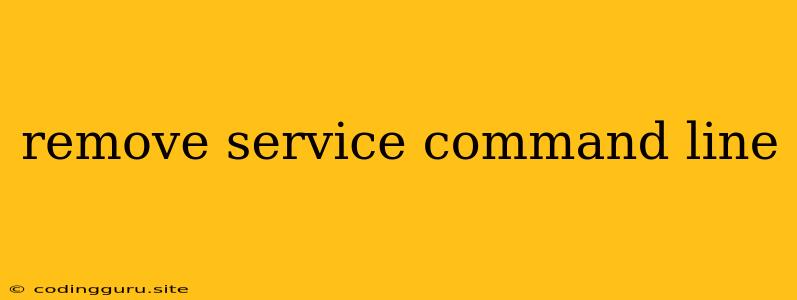Removing Services from the Command Line: A Comprehensive Guide
Managing services on your computer is a crucial task, especially for system administrators and developers. Sometimes, you might need to remove a service due to conflicts, incompatibility, or simply because it's no longer needed. The command line offers a powerful and flexible way to manage services, including removing them. This guide will walk you through the process of removing services from the command line in various operating systems.
Understanding Services and the Command Line
Services, also known as daemons, are background processes that run continuously on a computer, providing essential functionalities. They can range from managing network connections to running web servers. The command line is a text-based interface used to interact with your operating system directly.
Why Use the Command Line?
While graphical user interfaces (GUIs) are often more user-friendly, the command line offers several advantages for managing services:
- Precision and Automation: You can execute commands with precise syntax, eliminating any potential for human error. You can also script these commands for repetitive tasks, automating the process.
- Power and Flexibility: The command line provides access to a wide range of commands and utilities, offering more control and flexibility compared to GUIs.
- Efficiency: Command line operations are generally faster and more efficient than their graphical counterparts.
Removing Services Using the Command Line
The exact commands and steps for removing services vary depending on the operating system you are using. Here are some common methods for Windows, Linux, and macOS:
Windows
-
Identify the Service Name: You can use the
sc querycommand to list all available services and their names. For instance,sc query "MySQL"will show information about the MySQL service. -
Stop the Service: Before removing a service, you need to stop it. Use the
sc stopcommand followed by the service name. For example:sc stop MySQL -
Remove the Service: The
sc deletecommand is used to remove a service. Use the following syntax:sc delete MySQL
Linux (Ubuntu, Debian, CentOS, etc.)
-
Identify the Service Name: In Linux, services are typically managed using the
systemctlcommand. You can usesystemctl list-units --type=serviceto list all available services. -
Stop the Service: To stop a service, use
systemctl stopfollowed by the service name. For instance:systemctl stop mysql.service -
Disable the Service: To prevent the service from starting automatically on system boot, use
systemctl disablefollowed by the service name.systemctl disable mysql.service -
Remove the Service: Depending on the package manager used (e.g., apt, yum), you can remove the service's corresponding package. For example:
sudo apt remove mysql-server
macOS
-
Identify the Service Name: macOS services are usually associated with specific applications. You can use the
launchctlcommand to manage them. -
Stop the Service: Stop the service using the
launchctl unloadcommand followed by the service's path. For example:launchctl unload -w /Library/LaunchDaemons/com.example.myservice.plist -
Remove the Service: Delete the service's configuration file located in the
LaunchDaemonsorLaunchAgentsdirectories.
Best Practices for Removing Services
- Verify the Service Name: Always double-check the service name before removing it to avoid accidentally deleting a crucial system service.
- Backup Before Removal: Consider backing up important data or configuration files related to the service before removing it.
- Restart Your Computer: After removing a service, restart your computer to ensure the changes are applied correctly.
- Consult Documentation: If you are unsure about a specific service or its removal process, refer to the documentation of the application or service.
Common Errors and Troubleshooting
- Access Denied: You might encounter "Access Denied" errors if you don't have the necessary administrative privileges to remove a service. Run the command as administrator or root user.
- Service Not Found: If you receive a "Service not found" error, make sure the service name is correct and the service is installed on your system.
- Dependency Issues: Some services might depend on other services. Removing a dependent service could cause issues with other applications or system functions.
Alternatives to Command Line Removal
While the command line is a powerful tool for service management, alternative methods are available:
- Graphical User Interfaces: Many operating systems offer graphical tools to manage services, which may be easier for some users.
- Service Manager Tools: Specialized service management tools like
nssm(for Windows) provide a GUI interface for managing and removing services.
Conclusion
Removing services from the command line is a fundamental task for system administrators and developers. By understanding the commands and processes involved, you can efficiently and effectively manage services on your system. Remember to always be cautious and double-check before removing any service to avoid disrupting system functionality.
